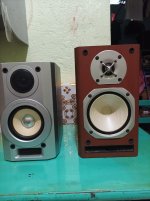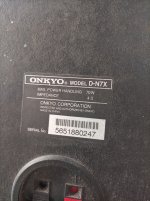Moving forward, Let's see what we know or suggest might be the case.
So the easy answer is no, you can't simply parallel them and you are best off using two amps with PLLO XO's, or using one stereo amp with passive XO's and make them essentially a three way system. Not too tough I either way.
If all else fails, see if they were un-smart enough to do a passive XO in the box itself.
- The original head unit uses at least two stereo amps.
- They are likely actively XO'd.
So the easy answer is no, you can't simply parallel them and you are best off using two amps with PLLO XO's, or using one stereo amp with passive XO's and make them essentially a three way system. Not too tough I either way.
If all else fails, see if they were un-smart enough to do a passive XO in the box itself.
I think the front speakers have a passive xo. To make them a 3-way will not be very rewarding, the big coils needed likely exceed the value of the speakers several times and the subwoofers are likely too quiet on their own as far as I know the Panasonic speakers and compact stereo sets of the time, so there are likely much more parts needed.
Indeed, they are. I'm always for cheap and effective solutions and quite good at improvising but I haven't been able to come up with that! You learn something new every day.
For me it's very similar, I often try to achieve the same result with a more economical way or try to improve something in the most practical way. The best way to do it is to analyze the problems. I often see how ppl propose solutions which will work but are magnitudes more expensive than actually needed. Thinking outside of the box helps there, many ppl are excellent in one field and try to solve everything with it, often overlooking a simpler way for it.
Okay, personalities aside for a moment as I don't like conflict on a sunny Sunday afternoon and am apt to pull the trigger rather quickly.
Thank you for your understanding and cooperation.
A good free lesson Cal ;-o.
Hi all, is there a simple way to check if the tweeter of the Onkyo speaker is working? While listening to it, all I could hear seemed to be coming from the woofer, yes it does have some highs but to my ears the low frequency overpowers it. I've listened to a mixed of music material but they seem to have the same energy, not much coming from the highs. The highs is very audible (and evident) when listening from the Panasonic speaker.
Attachments
The Onkyo is on the right.
The first thing I would do is gain access to the tweeter terminals, disconnect the connecting wires, and measure the resistance across the terminals using the ohms scale on a multimeter. You should expect a working tweeter to give a reading of somewhere between, say, 3 ohm and 6 ohm.
Let us know how that goes in order to start the ball rolling.
EDIT: Does the tweeter problem affect both of the Onkyo speakers or just one of them?
The first thing I would do is gain access to the tweeter terminals, disconnect the connecting wires, and measure the resistance across the terminals using the ohms scale on a multimeter. You should expect a working tweeter to give a reading of somewhere between, say, 3 ohm and 6 ohm.
Let us know how that goes in order to start the ball rolling.
EDIT: Does the tweeter problem affect both of the Onkyo speakers or just one of them?
Last edited:
Thanks Galu, the pair of Onkyo's sounds lacking in highs to me. It just occured to me that this symptom could be a fault in the speakers, they are surplus items from Japan of course.
I do know that high frequency can be heard from the tweeters when you stick your ears closer to it but the Onkyo's sounds dead to me. I am not so familiar with these Onkyo types though, this is my first time hearing them.
I do know that high frequency can be heard from the tweeters when you stick your ears closer to it but the Onkyo's sounds dead to me. I am not so familiar with these Onkyo types though, this is my first time hearing them.
I have a pair of those Onkyo D-N7X. What intrigued me about them were the midwoofers. They are some sort of composite, synthetic one piece cones with very thin surrounds. It seems Onkyo was pursuing something along the lines of B&W's FST midrange drivers, but tried to adapt it to be a midwoofer. They used similar woofers in a variety of bookshelf speakers packaged with their mini systems and also in their very pricey D-TK10 flagship model.
Now, to the tweeter problem. It's likely that you're tweeters are working ok. The problem is the tweeter sensitivity is too low. The first pic below depicts the raw responses of the drivers, showing the tweeter being drowned out by the breakup of the woofer. The "crossover" is just a 2.2uF cap on the tweeter. The second pic is with the cap in place. It does help protect the tweeter but obviously does nothing to help the overall response at high frequencies.


Now, to the tweeter problem. It's likely that you're tweeters are working ok. The problem is the tweeter sensitivity is too low. The first pic below depicts the raw responses of the drivers, showing the tweeter being drowned out by the breakup of the woofer. The "crossover" is just a 2.2uF cap on the tweeter. The second pic is with the cap in place. It does help protect the tweeter but obviously does nothing to help the overall response at high frequencies.
- Home
- Loudspeakers
- Multi-Way
- Micro-component speakers


